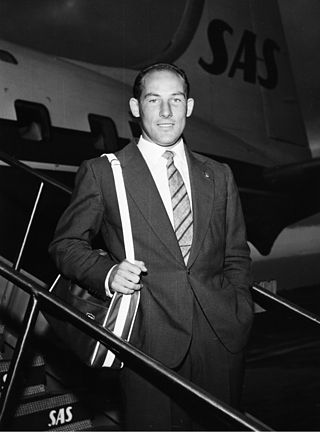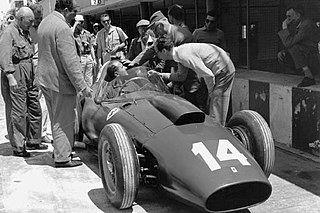
Sir Stirling Craufurd Moss was a British Formula One driver. An inductee into the International Motorsports Hall of Fame, he won 212 of the 529 races he entered across several different motorsports competitions and has been described as "the greatest driver never to win the Formula One World Championship". In a seven-year span between 1955 and 1961, Moss finished in second place four times and in third place three times.

The 1954 Belgian Grand Prix was a Formula One motor race held at Spa-Francorchamps on 20 June 1954. It was race 3 of 9 in the 1954 World Championship of Drivers. The 36-lap race was won by Maserati driver Juan Manuel Fangio after he started from pole position. Maurice Trintignant finished second for the Ferrari team with Fangio's teammate Stirling Moss in third.

The 1958 Argentine Grand Prix was a Formula One motor race held on 19 January 1958 at Autodromo Municipal Ciudad de Buenos Aires Circuit. It was race 1 of 11 in the 1958 World Championship of Drivers and race 1 of 10 in the 1958 International Cup for Formula One Manufacturers. The race was the sixth Argentine Grand Prix. It was held on the #2 variation of the circuit. The race was held over 80 laps of the four kilometre circuit for a total race distance of 313 kilometres.

The 1958 Monaco Grand Prix was a Formula One motor race held on 18 May 1958 at Monaco. It was race 2 of 11 in the 1958 World Championship of Drivers and race 2 of 10 in the 1958 International Cup for Formula One Manufacturers. The race was the 16th Monaco Grand Prix and was held over 100 laps of the three kilometre circuit for a total race distance of 314 kilometres.

The 1957 Formula One season was the 11th season of FIA Formula One motor racing. It featured the 8th World Championship of Drivers which was contested over eight races between 13 January and 8 September 1957. The season also included nine non-championship races for Formula One cars.

The 1955 Formula One season was the ninth season of FIA Formula One motor racing. It featured the sixth World Championship of Drivers, which was contested over seven races between 16 January and 11 September 1955. The season also included several non-championship races for Formula One cars.

Harry Lawrence O'Reilly Schell was an American racing driver. He was the first American driver to start a Formula One Grand Prix.

Maserati 350S is a series of three racing cars made by Italian automobile manufacturer Maserati, built by Giulio Alfieri, with aluminum body design by Medardo Fantuzzi, both Maserati engineers. The 350S was built to experiment with a new straight-six engine while a V8 engine was being developed in the factory.

The Maserati 250F was a racing car made by Maserati of Italy used in '2.5 litre' Formula One racing between January 1954 and November 1960. Twenty-six examples were made.

The Maserati 300S was a racing car produced by Maserati of Italy between 1955 and 1958 to compete in the FIA's World Sportscar Championship. Twenty-six examples were produced.

The Maserati 450S is a racing car made by Italian automobile manufacturer Maserati for participating in FIA's endurance World Sportscar Championship racing. A total of nine were made.
The 1957 World Sportscar Championship season was the fifth season of the FIA World Sportscar Championship. It was a series for sportscars that ran in many worldwide endurance events. It ran from 20 January 1957 to 3 November 1957, and comprised seven races.

The Race of Two Worlds, also known as the 500 Miglia di Monza, was an automobile race held at the Autodromo Nazionale Monza, Italy in 1957 and again in 1958. It was intended as an exhibition event, allowing American teams from the United States Auto Club (USAC) National Championship to compete directly against teams from the Formula One World Championship based in Europe. The two types of cars competed on the banked oval at Monza which had been completed in 1955. Due to the similarity to the Indianapolis Motor Speedway, where the USAC teams ran the Indianapolis 500, the event earned the nickname Monzanapolis.
This article documents the status of motorsports in the 1950s.
Throughout its history, the Italian auto manufacturer Maserati has participated in various forms of motorsport including Formula One, sportscar racing and touring car racing, both as a works team and through private entrants. Maserati currently competes in Formula E in partnership with the Monaco Sports Group (MSG) as Maserati MSG Racing.

The Ferrari 335 S was a sports racing car produced by Italian manufacturer Ferrari between 1957 and 1958. The car was a direct response to the Maserati 450S which with its 4.5-litre engine was threatening to overpower the 3.8-litre 315 S and 3.5-litre 290 MM. Four cars were produced in total.

The Maserati 250S, and its derivative and version, the 250 Sport, are sports racing cars, designed, developed and built by Italian car manufacturer Maserati, between 1954 and 1957. Only two models were produced.

Vittorio Jano designed a new 60° V12 engine for sports car racing for Ferrari. This new engine, introduced in 1956, combined elements of both Colombo and Lampredi engines with new features. Engine architecture was more of Lampredi school but retained smaller Colombo internal measurements. Jano moved to Ferrari along with his designs for the Lancia D50 in 1955 and went on to design not only a new V12 but also a family of the Dino V6 engines soon after. Some of the technical ideas came from the Jano's Lancia V8 DOHC engine, intended for Formula One. This family of engines replaced Lampredi inline-4s known from Ferrari Monza line and went on to win many international races and titles for Ferrari. The design team comprised Jano as well as Vittorio Bellentani, Alberto Massimino, and Andrea Fraschetti.

The Ferrari 412 MI was a single-seater produced by Italian manufacturer Ferrari in 1958. It was a one-off purpose-built racer for the second edition of the 500 Miles of Monza to compete against American race cars. The 412 MI scored a pole position and finished the race on a third place, which was the best European-entry result. As per naming convention "412" stood for 4-litre, 12-cylinder engine. The "MI" suffix stood for "Monza-Indianapolis".

The Ferrari 326 MI was a single-seater manufactured by Ferrari in 1958. It was a one-off race car purpose-built for the second edition of the 500 Miles of Monza. It was one of the two special cars created to compete with American race cars on an Italian race track. Following the naming convention, "326" stood for 3.2-litre, 6-cylinder engine. The "MI" suffix stood for "Monza-Indianapolis".






















